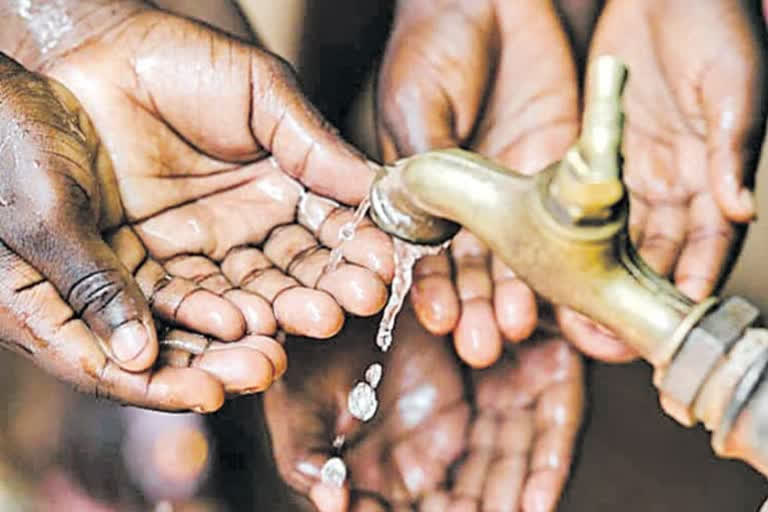Hyderabad: The availability of water, an important source for the sustenance of all living beings, continues to decline. Water scarcity has become a major problem worldwide today. Lack of focus on water management, contamination of existing water resources and rendering them unusable are the main reasons for this. Of the world's total water, freshwater is about three per cent. That is why there are always conflicts and tensions between people, regions, states and countries for water. With the passing of time, conditions are deteriorating. However, it is a pity that no one pays proper attention to issues such as efficient use and conservation of water for future generations.
Also read: Man burns money on gas stove as ACB raids his house
Water wastage
According to estimates by the National Water Commission (2019), the country needs three lakh crore cubic meters of water annually. According to the NITI Aayog (2021) statistics, considering the area of the country and the average annual rainfall in India during 1985-2015, about four lakh crore cubic meters of water was available annually. Due to wastage through water vapour, geographical differences, etc., the total average annual water availability in the country is 1.86 lakh crore cubic meters! Of this, 69,000 crore cubic meters (36.92 per cent) comes from groundwater resources and 43.3 thousand crore cubic meters (23.17 per cent) from groundwater resources. This means that out of the total water, only 1.12 lakh crore cubic meters is being used. The remaining 74,000 crore cubic meters (39.91 per cent) is wasted.
Also read: TDP's presence in Telangana Assembly ends as MLAs join TRS
Compared to other rivers in the country, the catchment area of the Ganges, Brahmaputra and Indus rivers (14.2 lakh sq km) is very large. So naturally, the water available through the rain in these areas is high. The river basins of the Ganges and Brahmaputra alone account for 46% of the average annual groundwater availability in India. River water accounts for 60% of India's surface water resources. The South Indian Rivers Godavari, Krishna and Cauvery also have high water flow. Groundwater consumption is higher in some parts of the northwest and south compared to other different parts of the country. It is also high in Punjab, Haryana, Rajasthan and Tamil Nadu. Groundwater use is very low in states like Chhattisgarh, Odisha and Kerala. According to the National Groundwater Authority (2011), various parts of the country (37.37 per cent blocks) are facing a water crisis. According to the NITI Aayog (2021) figures, more than half of the country's population already does not have access to safe drinking water. This will have a serious impact not only on food security but also on the country's economic development.
Also read: India and Bangladesh relation moves on a beneficial new track
According to the estimates of the Union Ministry of Hydropower (2021) the per capita water availability in the country in 1951 was 5,177 cubic meters. By 2011 it had dropped to 1,545 cubic meters. It is projected to further shrink to 1,341 cubic meters by 2025 and to 1,140 cubic meters by 2050. According to international standards, if the per capita water availability is less than one thousand cubic meters, it is considered as water scarcity and if it is between 1,000-1,700 cubic meters, it is considered a grave water situation. Water conservation is said to be satisfactory if it exceeds 1,700 cubic meters. This means that the water problem in the country will intensify in the next 30 years. In most parts of the country, about 70 per cent of groundwater is already polluted with human and industrial waste. About 40 per cent of groundwater is polluted with minerals, such as high fluoride and other toxic chemicals. The World Health Organization (2020) estimates that overuse of bio-chemicals in water is responsible for 80 per cent of the world's health problems.
Also read: 'Pace of vaccination vital for economic growth'
Increased awareness on water conservation
In addition to solutions to the water crisis in India, environmental protection measures are also needed. Experts warn that if water shortages continue, it will lead to divisions in society and may lead to uprisings. Therefore, the Central and State Governments have to act with accountability. They must move actively to control population growth as well as curb water wastage. Water can be gainfully utilized by connecting rivers. Recharge pits should be set up extensively to store rainwater in the ground. Ponds, ditches and wells should be protected. Awareness should be created among the people on water conservation. Water management should be carried out on a war footing in scientific methods. If the people and NGOs come forward and fully co-operate with the governments, we can face the problem of water scarcity to some extent in the future. It is everyone's responsibility to see that our future generations do not face a water crisis.



